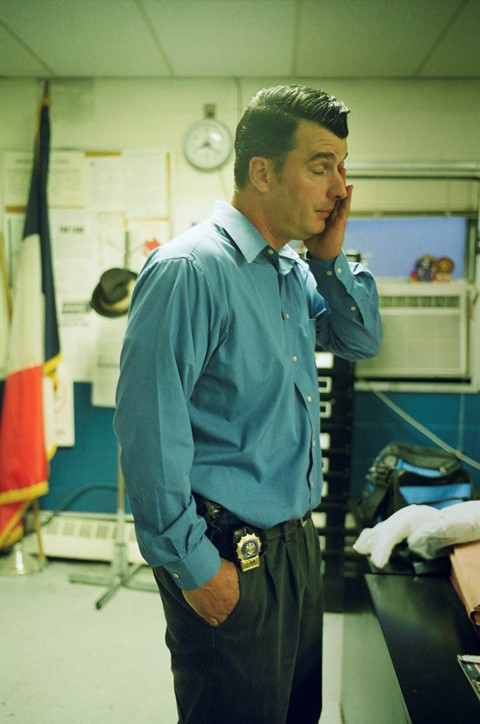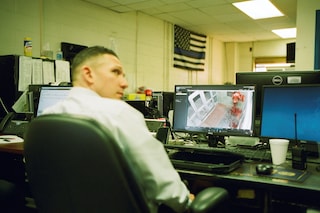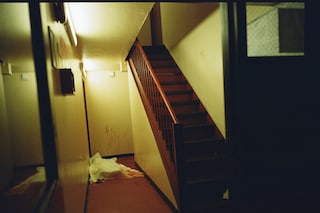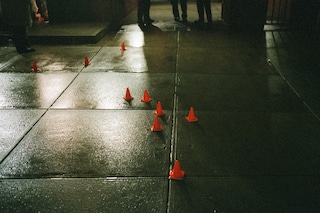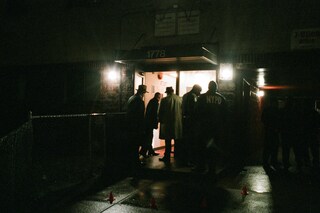The photographer spent two years documenting the reality of life in the homicide squad of one of NYC’s most dangerous precincts
A police detective slouches in an office chair in the squad room, wringing his hands, absorbed by something happening out of shot – a television screen or a conversation taking place beyond the frame. A colleague is on the phone, leaning on the desk and looking disgruntled with shirt sleeves rolled up his thick arms. This is a machismo landscape of filing cabinets, warrants, cigars, stars and stripes, and styrofoam coffee cups.
It’s nighttime. The same police detective is backlit by the lighted entrance to a housing project. Silhouetted by the sodium light, we can make out his trilby and the trenchcoat. It’s been a long night.
The stairwell of what looks like a fire escape, lit by disorientingly bright strip lighting. What at first glance looks like a bundle of dirty clothes gradually reveals itself as a human body, face down on the concrete. It’s a shapeless form other than the feet, the soles of which look so tender and vulnerable in dirty socks.
Two detectives unwind in a dive bar after a long shift. They’re still in their overcoats but their ties are loosened. One raises a tumbler of whisky to his lips, the other is cracking a joke. It’s the kind of joint frequented by criminals and cops alike, but everyone is off duty tonight.
These aren’t scenes from Serpico or Donnie Brasco, these are just a few documentary images from Theo Wenner’s new book Homicide (Rizzoli). The acclaimed fashion photographer spent two years embedded among the homicide detectives of Brooklyn's 90th Precinct, a district of New York with one of the highest murder rates in the city. Spending long hours in the squad room, accompanying them in unmarked cars through the city at night to crime scenes, and breakfasting in diners at dawn, Wenner was able to document the everyday life of this unique and much-mythologised corner of American life.
While his images portray the unflinching reality of life as an NYPD detective, they also contain all the tropes and conventions of every archetypal cop movie you’ve ever seen. It’s hard to determine what decade the pictures are taken in, everything from the dated decor in the squad room to the way they dress and present themselves appears like caricatures of TV detectives. Wenner considers the ways in which storytelling and self-mythologising shape and form the identity and culture of the homicide squad, “Are the detectives in the movies styled after them? Or are they styled after the detectives in the movies?”
Below, we talk to Wenner about life among the most elite homicide detectives in NYC, the traditions and rituals of group identity and acceptance, and the enduring memory of his first murder scene.
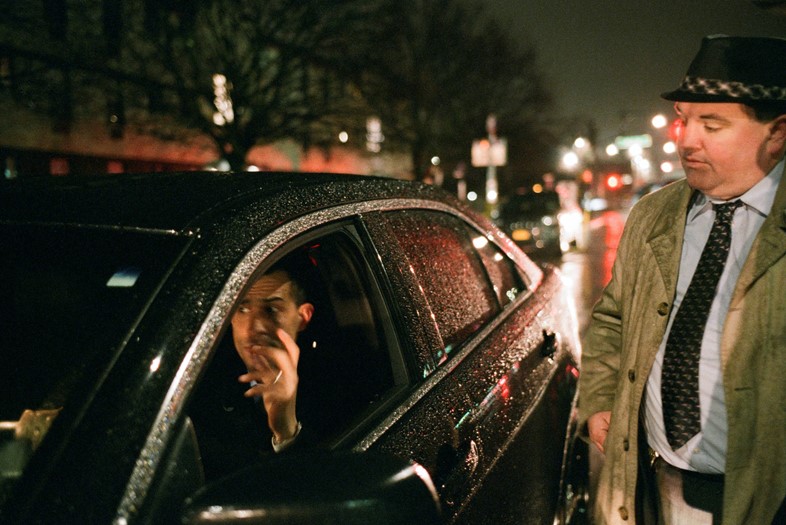
Please could you begin by introducing us to Brooklyn’s 90th precinct?
Theo Wenner: The NYPD puts the best homicide detectives in the most dangerous area of New York. This particular unit of detectives that I photographed has the highest murder rate, so they put the best detectives there – they’re kind of the New York Yankees of homicide detectives, the all-star team. So that was really interesting, to get to be with the best of the best in the area that is the busiest.
What did you find so alluring about this as a subject?
Theo Wenner: It’s really all the unspoken traditions, the codes and the culture of it... just the way they dress, the way they talk. So many traditions are passed on. And it’s such a closed-door world that you never get to see in real life, just in movies and books, which we’ve all seen many times. I was very fascinated to see what that actually is, and what it looks like.
There’s something about the images that feel quite timeless in a way, they’re not really anchored visually in the present decade.
Theo Wenner: It really is kind of stuck in time, you know? It feels like you could not necessarily pinpoint the fact that you’re in 2020. Especially the precinct itself, it looks like you’re in the 1980s... the colours of paint on the wall, the lighting, and then the way they dress is, I mean, I could not believe that they actually dress like that. It’s amazing. I just thought to myself, ‘Wow, the movies really got it right.’
“I guess it’s the type of murder that really struck me as very different. You know, it’s not the sophisticated serial killer who’s taunting the police and leaving cryptic clues everywhere” – Theo Wenner
You mentioned the culture and the rituals that take place among them. How would you describe the unique culture of that little world?
Theo Wenner: The culture of that world, it starts with the way they dress. And the slang, the way they talk to each other. They’re always telling stories and the legends get passed on, so you clearly start to see the traditions, it’s like it happens through osmosis. They’re all great storytellers because they talk to people all day – that’s the job... they’re interviewing people, they’re reading people, they’re telling stories, they’re making jokes, it’s all sort of storytelling. It lends itself to that. And, from there, I think a lot of the culture gets passed down, it soaks into the atmosphere.
It’s kind of unclear because they all are obsessed with detective movies and true crime shows and serial killers. Sometimes in the office, true crime is playing on the TV, so there is a sort of self-fulfilling prophecy that happens where they’re aware of the movies. Are the detectives in the movies styled after them? Or are they styled after the detectives in the movies?
Can you tell us some of the codes and conventions of their world?
Theo Wenner: I was just so fascinated by the language. The lingo they use is so incredible. For instance, when they have a prime suspect in a murder they say ‘we've got a guy that we like a lot’.
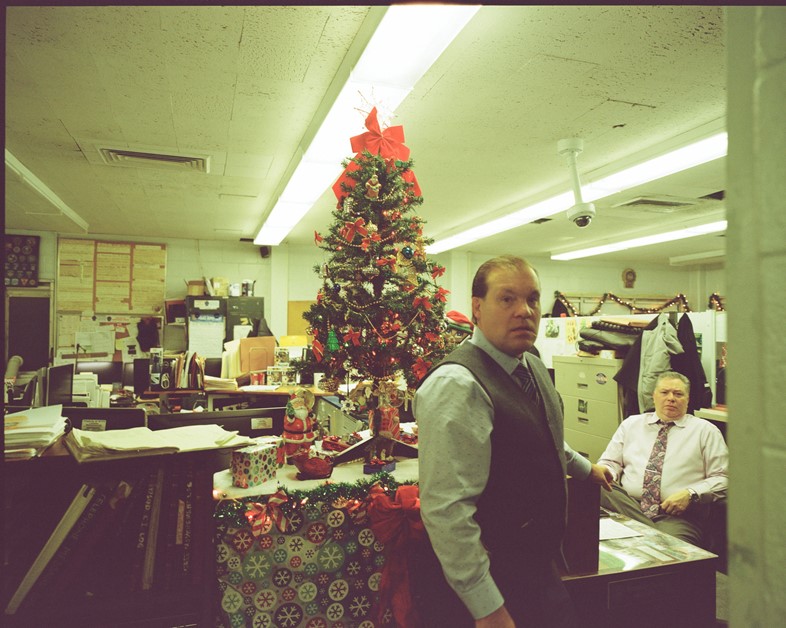
How did you ingratiate yourself within what must be such a tight and closed world?
Theo Wenner: I was just myself. I knew going in not to be anything but 100 per cent myself. Like, don’t pretend like you’re anybody else. Dress the way you dress, speak the way you normally speak. They break your chops in the beginning like, ‘Oh, you're a fashion photographer, you live in Manhattan.’ They make fun of you and if you make fun of them back and don’t change yourself then they have a lot of respect for that. So, I guess the answer to your question is don’t try to ingratiate yourself – that’s the best way to ingratiate yourself.
Their natural inclination is obviously to be suspicious. That’s their job. So you just slowly build their trust and start joking around with them. And, you know, you’re sitting there just hanging back and watching and slowly they start to let you in more and more. But this had never been done before, so there was no precedent. Eventually, they let me see everything and let me go everywhere with them.
As a culture, we’re obsessed with true crime. Were there any startling differences, in your experience, being confronted by real-life homicide versus the murders in movies and TV programs?
Theo Wenner: I guess it’s the type of murder that really struck me as very different. You know, it’s not the sophisticated serial killer who’s taunting the police and leaving cryptic clues everywhere. The murders are pretty grim and straightforward from what I saw... drug-related, gang-related, you know. It was just a reality check. There’s no interesting puzzle with some serial killer adversary taunting them with clues.
“You never forget your first murder. I mean, I had never seen a dead body before and that is something I’ll never forget” – Theo Wenner
The images have got a very particular aesthetic, which is quite stark and creates a really distinct kind of atmosphere. Was that something you envisioned? Or was it something that the subject matter dictated?
Theo Wenner: You know, when I was editing the book and looking at all the photos – of which there were thousands – I just started to realise that the majority of them are at night… everything happens at night in that world, so that really did construct an aesthetic. There are certain kinds of lighting at night. And a lot of murders happen in hallways for some reason. So it’s like you have these strong visual motifs that start to repeat themselves... nighttime, sodium lighting, hallways, staircases. You start seeing the same places over and over again, you’re always in the back of the unmarked police car, driving, looking through that back window.
And when you were on location in the crime scenes documenting them in your pictures, what kind of details or aspects caught your attention most?
Theo Wenner: It’s just those little tiny things that are so pedestrian that you would never normally notice but, all of a sudden, in that context, they take on such a powerful significance. There were just so many grim ironies. We went to this one homicide where a drug dealer had been murdered. The apartment was on the ground floor street level on this small side street in Brooklyn. The front door had this welcome doormat with bright red cartoon footprints. And then they open the door and there are just bright red blood drops down the hallway that are the same colour as this cartoon doormat. It looked like it was just a continuation of that red cartoon footprint.
What was the difference in the way that you surveyed those crime scenes and the way that the detectives were surveying them, do you think?
Theo Wenner: I guess the similarity is that you’re taking a photograph to capture all the information that you see. And I guess their same approach is that they’re looking for the story and the information that they see. And then, of course, they’re combing through all the technical detail. It’s very systematic when they arrive at a crime scene, there are procedures for preserving evidence and looking for fingerprints, the crime scene unit comes, and they are wearing white sterile suits. Every single person that goes into a crime scene has to sign in and give elimination fingerprints so they know if anything was touched it came from someone who signed into the crime scene.
And then I was really fascinated by the crime scene photographers. They have to use a 50mm lens so that there's no distortion. The way they photograph everything is with no artistic flair whatsoever, it just has to be so dry. But it’s fascinating because it’s just pure facts. I mean, those photos are really interesting in their own right.

You mentioned there were thousands of images that you must have amassed during that year. The process of reducing them and selecting which to include must’ve been difficult? How did you go about it? Were you conscious of not wanting to kind of impose a particular narrative on the book?
Theo Wenner: I wanted to start with information. You need to give certain information and context to set the scene, to show these characters and capture these unspoken codes. So I look for the pictures that speak to that idea. Some of them just say more than others – they mean something.
Are there any particular incidents or memories from that time that have really stayed with you more than others?
Theo Wenner: You never forget your first murder. I mean, I had never seen a dead body before and that is something I’ll never forget. I will remember every single detail about that moment. I remember the little things, the yellow M&M wrapper next to the body. It’s so clear to me, even talking to you right now. I remember what kind of lighting there was, what the smell was, what colour shirt the guy was wearing. It’s a very strong memory because it was such a powerful experience.
I just remember staring at this M&M wrapper next to this dead body, I just couldn’t stop staring at it. It was the weirdest thing. It was almost like it had a life of its own. And I was wondering, ‘Did the guy just eat that? It was almost like vibrating with a life of its own, you know?
Because it's been in close proximity to something so dramatic?
Theo Wenner: Exactly. That’s exactly right. Those little details when you walk into a crime scene take on so much extra significance it’s like you’re looking at these little moments of life. A video game remote control on a couch in a person’s apartment all of a sudden can take on this incredible significance. They’re frozen in time.
Homicide by Theo Wenner is published by Rizzoli and is available now.
